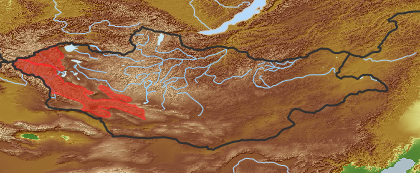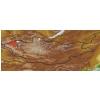| Class: | angiosperms |
| Order: | Sapindales |
| Family: | Biebersteiniaceae |
| Genus: | Biebersteinia |
| Scientific name: | Biebersteinia odora Steph. |
| Name acc. to: | Gubanov 1996 |
| Herbar: | list records  |
| Synonym: | Geraniaceae B. odora Steph. (acc. to Grubov 1982) |
| Description: | Strongly glandular fragrant dwarf semishrub, 10-30 cm high. Leaves linear-lanceolate, 1-pinnatisect with obtuse lobes. Flowers regular yellow in few flowered dense racemes. Fruits without beak. |
| Confuse with: | No near relatives due to monotypic state in Mongolia. |
| Comments: | All species of Biebersteinia possess a characteristic odour and are viscid to the touch. They all have medicinal properties and are used by the local people to some degree. Biebersteinia had traditionally been placed in the Geraniaceae, but there is now ample, mainly molecular, evidence that it comprises a separate family in the order Sapindales. |
| Link to Flora of China: | http://www.efloras.org/browse.aspx?flora_id=2&name_str=Biebersteinia+odora |
| open map in a new window |  |
| Habitat: | Stone fields and rocks in alpine belt (Grubov 2001). |
| Habit (i)general appearance of a plant | |
| Growth form: (i)Herb, shrub, tree or climber. | herb (i)Herbaceous, erect plant, up to 2m high, mostly with a leafy shoot; if perennial, shoots die to the ground each season, shoots are not woody
example: Artemisia pectinata 
perennial (i)Living for several to many years, as opposed to annual and biennial
shrub, subshrub or semishrub (i)Shrub, multi-stemmed, mostly (0.2) 0.5 - 5 m high, shoots woody up to the tip
example: Caragana leucophloea 
|
| Smell & Touch: (i)General appearance of the plant. | odor (i)Plant with an obvious scent
fragrant (i)Scent, which is pleasant
|
| Size of plant: (i)Attention: use flowering or fruiting specimens to assess plant height (many biennial plants possess only a basal rosette in the first year). | from 100 mm to 250 mm
from 250 mm to 600 mm
|
| Parasite status: (i)Is the plant a half- or full parasite? | no parasite/saprophyte (i)Plant fully autonomous, leaves with chlorophyll
example: Most plants, Ranunculus  inherited by family Biebersteiniaceae: no parasite/saprophyte inherited by family Biebersteiniaceae: no parasite/saprophyte
|
| Water or terrestrial plant: (i)Where do the plants grow? | terrestrial (i)Plant grows on dry land
example: Orostachys spinosa
|
| Leaf (i)expanded, usually photosynthetic organ of a plant (including phylloclades) | |
| Leaf development: (i)Structure and development of leaves. | with green leaves (i)Plant with green leaves
|
| Leaf arrangement: (i)Arrangement of leaves at the stem. | alternate (i)One leaf per node; distiche: arranged in two vertical rows, equitant
example: Phragmites  
basal rosette (i)Leaves positioned at the base of the stem; stem often without leaves, no visible internodes (but flowers often on erect stems, and these may have few leaves)
example: Limonium, Potentilla, Plantago; also used in Liliales with basaly crouwded leaves (Tofieldia, Zigadenus etc.) 
|
| Simple or divided leaves: (i)Are the leaves simple or completely divided in several parts? Blade of the leaf entire or (more or less) deeply dissected. Attention: There are various appearances of the leaf margin (from entire to toothed and lobed). Here, we ignore this and ask only for dissections that separate the leaf for more than one third of its length or width, whatever is smaller. Sometimes, it is difficult to tell apart compound leaves from a shoot system with simple leaves: look for stipulae and/or axillary buds at the ground of the leaves: if only some possess these structures, the others are most likely leaflets of a compound leaf. | compound (i)Composed of several similar parts
pinnate (i)With leaflets on both sides of an axis, at least 2 pairs or more
example: Onobrychis 
|
| Length of leaves: (i)How long is the leaf, be carefull in compound leaves, measure the complete leaf. | more than 50 mm
|
| Width of leaves: (i)How broad is the leaf, be carefull in compound leaves, measure the complete leaf. | 1-3 cm
> 3 cm (i)6 arten prüfen
|
| Leaf apex: (i)Appearance of the tip of leaf resp. leaflets in compound leaves. | rounded (i)With a round apex
example: Trifolium 
obtuse (i)Sides coming together at the apex at an angle greater than 90 degrees
example: Fallopia convolvulus 
|
| Leaf margin: (i)Structure of leaf margin (or that of a leaflet in case of compound leaves). Attention: Here we ask for the leaf margin, defined as all those dissections that separate the leaf for less than one third of its length or width, whatever is smaller. To be worked out: how to handle margin of pinnate leaves? | lobed (i)Curved division, be aware of deeply lobed leaves than compare with palmatisected (character: leaf division)
example: Crataegus, Dryas, Rubus humulifolius 
|
| Leaf base: (i)The angle the leaf blade forms with a real or imaginary (sessile leaves) petiole. Attention: Here, we consider only the base of leaves or leaflets (in case of compound leaves). | cuneate (i)Tapering gradually, angle > 90° - 120°
example: Thalictrum, Betula fruticosa 
|
| Petiole: (i)Leaf divided into stalk (petiole) and blade. | with (i)Leaves with petiole (stalk) 
|
| Stipule: (i)Leaflets at the base of the petiole, these are smaller and of different shape. | pair (i)A pair of free stipulae
example: Lathyrus, Trifolium 
|
| Leaf colour upper side: (i)Shades of green on the leaf, upper side. | green (i)Clear green
example: Tribulus terrestris
|
| Leaf colour lower side: (i)Shades of green on the leaf, lower side. | green (i)Clear green, in most species
example: Angelica decurrens
|
| Leaf veination: (i)Arrangement of the main veins of a leaf. | pinnate (i)One main vein, several side veins, sometimes inconspicuous
example: Cicerbita     inherited by family Biebersteiniaceae: pinnate inherited by family Biebersteiniaceae: pinnate
|
| Flower (i)reproductive portion of the plant, consisting of sepals, petals, stamens, and pistils | |
| Flower appearance and pollination: (i)General appearance of the flower. | attractive, animal-pollinated (i)attractive and coloured flowers, mostly large, attracting surely animals
example: Trollius, Rosa, Chamaerhodos
|
| Flower colour: (i)Attention: assess colour of the most colourful parts of the flower, but not of the stamens; be aware of single plants with a mutation (mostly white) on flower colour. | yellow to orange (i)Pale to golden yellow
example: Ranunculus, Crepis
|
| Perianth arrangement: (i)Attention: in some plants, flowers may be dimorphic in different ways (dioecious or gynodioecious). If flowers vary, record the characters of the most showy flowers. | double, different (i)Two types of perianth leaves, differently coloured (sepals: outer periant leaves, usually greenish, and petals: inner perianth leaves, usually coloured)
example: Parnassia  
|
| Diameter of flower: (i)Diameter of flower or flower head. | from 5 mm to 10 mm (i)
example: Stellaria
from 10 mm to 20 mm (i)
example: Potentilla
|
| Flower symmetry: (i)Symmetry of the perianth leaves. Attention: to assess this character, look on sepals, petals and stamens, but neglect carpels and ovary. | radiary, regular (actinomorphic) (i)More than two axis of symmetry
example: Saxifraga: 5; Iris: 3 
|
| Flower form: (i)common forms of flowers ? Veronica | simple (flat) - Do not confuse with inflorescences as in some Asteraceae (i)Petals spread out, flower appearing flat
example: Mollugo, Trientalis, Pulsatilla, Saxifraga 
|
| Sepal number: (i)Number of sepal leaves (outer perianth leaves, calyx leaves, mostly greenish). Attention, this character applies only for flowers separated in sepals and petals, thus excluding most monocots. Be aware of the bracts (involucral leaves) of Asteraceae flowerheads, do not qualify these as sepals! Be also aware in Rosaceae is often an epicalyx developed, in this case count all parts. | 5 (i)
example: Polemonium
|
| Sepal fusion: (i)To which degree are the sepal leaves connected? Attention, this character applies only for flowers separated in sepals and petals, thus excluding most monocots. Be aware of the bracts (involucral leaves) of Asteraceae flowerheads, do not qualify these as sepals! | free (i)All leaves separate from each other
example: Geranium
|
| Petal / Tepal number: (i)Number of petal leaves (inner perianth leaves, usually coloured). | 5 (i)
example: Potentilla
|
| Petal / Tepal fusion: (i)To which degree are the petal leaves connected? Petals sympetalous. | free (i)all petal leaves separate from each other
example: Anthriscus
|
| Spur: (i)A hollow, slender, sac-like appendage of the perianth leaves, storing nectar. | no spur (i)Flower without appendage
example: Peganum
|
| Stamen number: (i)Attention: We ask for the reproductive organs of the flower dispersing pollen. Count only fully fertile stamens, not staminodia (e.g. Parnassia). | 10 (i)
example: Silene
|
| Stamen fusion: (i)To which degree are the stamens fused? Attention: Whereas the pollen sacs itself are often free., their stalks (filaments) may be fused. Here, we count them as fused if they are together over at least one thirth of their length. | free (i)Stamens with separate bases
example: Malus
|
| Pistil number: (i)Number of pistils (female floral organs: style, if developed; stigma and carpels/ovary together build the pistil). | 1 (i)One carpel, but clearly one stigma
example: Pyrola, Primula, Alyssum
|
| Carpel number: (i)Number of carpels (carpel: forming a simple pistil or part of a compound pistil, modified leaf). | 5
|
| Carpel fusion: (i)To which degree are the carpels (modified leaf forming simple pistil or part of a compound pistil) fused. | fused (i)Carpels united into an ovary, only styles are free
example: Malus, Berberis
|
| Style number: (i)Portion of the pistil connecting the stigma to the ovary. | 5
|
| Stigma number per style: (i)Number of stigmas per style. | 1 (i)One stigma, sessile or with a developed style
|
| Ovary position: (i)For entirely or partly fused carpels, describe their position in relation to the insertion point of perianth leaves (best done by doing a longitudinal section of a flower). | superior (hypogynous) (i)Base of carpels attached above insertion point of perianth leaves, carpels free or fused
example: Delphinium, Anemone  
|
| Sex: (i)Distribution of male and female organs among flowers, only most commonly cases. | bisexual, hermaphrodite (i)All or nearly all flowers of a plant with male and female parts
example: Haplophyllum, Chenopodium
|
| Inflorescence (i)flowering part of a plant, describes the arrangement of the flowers on the flowering axis | |
| Inflorescence: (i)Structure of the inflorescence. | Flowers in inflorescence (i)No solitary flowers
|
| Inflorescence type: (i)Types of inflorescence. Attention: We here ask for the botanical nomenclature of inflorescences, which is sufficiently complicated. Tick only, if you are certain, or tick all inflorescence types that appear similar of these of the plant in question. | raceme (i)Stalked flowers arranged along a simple main axis, often one by one in the axils of leaves, maturing from bottom upwards
example: Aconitum barbatum 
|
| Fruit (i)the seed bearing organ, with or without adnate parts; a ripened ovary and any other structures which are attached and ripen with it. Aggregate fruits are handled like simple fruits for determination. | |
| Consistency: (i)Fleshy fruits or dry fruits, see dispersal adaptations for further classification. | dry (i)With a dry outer shell, no fleshy parts, but seed (embryo) could be edible
|
| Splitting of fruit: (i)Is a solitary fruit splitting into fruitlets? The fruit splits into separate one-seeded segments at maturity (schizocarp). | splitting
in 5 parts (i)
example: Geraniaceae 
|
| Root / shoot below ground (i)plant part below ground (in most cases), including below ground shoots, without leaves | |
| Root type: (i)Organisation of the roots. | allorhizous (i)Plant with a conspicuous tap root, one larger tap root with side roots
example: Dicotyledonae  inherited by order Sapindales: allorhizous inherited by order Sapindales: allorhizous
|
| Distribution (i)region where the plant is likely to be found | |
| Distribution (Veg. Zones): (i)acc. to Grubov 1952 | Khobdo (i)In distribution data often named as '6' 
Mongolian Altai (i)In distribution data often named as '7' 
acc. to: Gubanov 1996 |